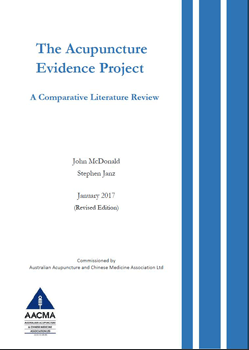The Acupuncture Evidence Project
The Acupuncture Evidence Project – A Comparative Literature Review 2017
Summary information
Please Note: Anyone making claims about the effectiveness of acupuncture in their advertising should note that advertisers must not advertise health benefits of their services when there is not acceptable evidence that these benefits can be achieved.
Under the National Law, the evidence needed for therapeutic claims in advertising and the evidence to be used in clinical decision-making about particular treatments is different. A higher standard of evidence is required to support claims made in advertising regulated health services. This is because in advertising, a statement may be easily misinterpreted or taken out of context and then become misleading. It is the overall impression created by the advertising that will be judged and, as such, it is possible for statements that are technically true to be misleading or deceptive in certain contexts.
While the findings of this project might be used to inform clinical decision-making, it should not be relied upon to make claims in advertising.
For further information about the kind of evidence necessary to support claims made in advertising, please refer to the Frequently Asked Questions about advertising and evidence, available on AHPRA’s website.
The Chinese Medicine Board of Australia has also published a position statement about making therapeutic claims in advertising and Check your Advertising: Chinese medicine examples – which outlines examples of advertising claims that don’t meet the legal requirements and how to make them compliant.
Publishing Date: February 2017. Reissued April 2017 with the Plain English Summary reproduced at the beginning of the document.
Available in Print: Yes
Citation: This document should be cited as: McDonald J, Janz S. The Acupuncture Evidence Project: A Comparative Literature Review (Revised Edition). Brisbane: Australian Acupuncture and Chinese Medicine Association Ltd; 2017. http://www.acupuncture.org.au/
Further information: aacma@acupuncture.org.au
Download
Advice for practitioners – print hardcopies of the plain English version on double sided A3 paper. Fold into A4 brochures to place in your clinic for promotional purposes.

Synopsis:
Background
Evidence of effectiveness underpins the validity of all health care interventions. Acupuncture has been practised for thousands of years; research into its effectiveness and cost effectiveness is in its relative infancy. The Australian Acupuncture and Chinese Medicine Association Ltd (AACMA) identified the need for an updated review of the literature with greater rigour than was possible in the past and commissioned The Acupuncture Evidence Project.
Methods
This review draws on two prior comprehensive literature reviews, one conducted for the Australian Department of Veterans’ Affairs (DVA) in 2010 and another conducted for the United States Department of Veterans Affairs (USVA) in 2013 (1, 2). The research identified by these reviews was pooled, then a search of further literature from 2013 to 2016 was conducted.
Trials were assessed using the National Health and Medical Research Council (NHMRC) levels of evidence, with risk of bias assessed using the Cochrane GRADE system (3, 4). Results have been tabulated to indicate not just the current state of the evidence, but to indicate how the quality and quantity of evidence has changed from 2005 to 2016.
In this review, 122 conditions across 14 broad clinical areas were identified and, of these, only five conditions rated at ‘no evidence of effect’. Evidence of cost-effectiveness was identified for 10 conditions, and evidence for safety was identified for nine conditions. The level of evidence was found by this review to have increased for 24 conditions.
It has been estimated that there is a 17-year time lag in translating clinical research into clinical practice (5). During this time patients are being deprived of the benefit of a proven therapy. Health policy makers now have eight clear conditions associated with a significant burden of disease where acupuncture should be integrated into current clinical guidelines without further delay. Placebo-controlled clinical trials consistently underestimate the true effect size of acupuncture (as discussed in section 1.4), yet they have still demonstrated NHMRC Level I evidence for the effectiveness of acupuncture for a further 109 conditions. This review has found a significant improvement in both the quality of studies and the levels of evidence supporting acupuncture since the most recent reviews conducted by the Australian and US Departments of Veterans Affairs.
References
- Biotext. Alternative therapies and Department of Veterans’ Affairs Gold and White Card arrangements,. In: Australian Government Department of Veterans’ Affairs, editor.: Australian Government Department of Veterans’ Affairs; 2010.
- Hempel S, Taylor SL, Solloway MR, Miake-Lye IM, Beroes JM, Shanman R, et al. VA Evidence-based Synthesis Program Reports. Evidence Map of Acupuncture. Washington (DC): Department of Veterans Affairs; 2014.
- National Health and Medical Research Council. NHMRC additional levels of evidence and grades for recommendations for developers of guidelines. National Health and Medical Research Council; 2009.
- Balshem H, Helfand M, Schunemann HJ, Oxman AD, Kunz R, Brozek J, et al. GRADE guidelines: 3. Rating the quality of evidence. Journal of clinical epidemiology. 2011 Apr;64(4):401-6.
- Morris ZS, Wooding S, Grant J. The answer is 17 years, what is the question: understanding time lags in translational research. Journal of the Royal Society of Medicine. 2011 Dec;104(12):510-20.